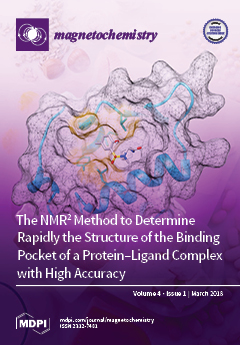Five new anilato-based, Ln(III)-containing, layered compounds have been prepared with the asymmetric ligand chlorocyananilato (C
6O
4(CN)Cl)
2−; different Ln(III) ions Ce(III), Pr(III), Yb(III), and Dy(III); and the three different solvents H
2O, dimethylsolfoxide (DMSO), and dimethylformamide (DMF). Compounds
[...] Read more.
Five new anilato-based, Ln(III)-containing, layered compounds have been prepared with the asymmetric ligand chlorocyananilato (C
6O
4(CN)Cl)
2−; different Ln(III) ions Ce(III), Pr(III), Yb(III), and Dy(III); and the three different solvents H
2O, dimethylsolfoxide (DMSO), and dimethylformamide (DMF). Compounds [Ce
2(C
6O
4(CN)Cl)
3(DMF)
6]·2H
2O (
1), [Pr
2(C
6O
4(CN)Cl)
3(DMF)
6] (
2), [Pr
2(C
6O
4(CN)Cl)
3(DMSO)
6] (
3), [Yb
2(C
6O
4(CN)Cl)
3(DMSO)
4]·2H
2O (
4) and [H
3O][Dy(C
6O
4(CN)Cl)
2(H
2O)]·4H
2O (
5) show the important role that the Ln(III) size, as well as the size and shape of the solvent may play in the crystal structure of each compound. Compounds
1–
4 present (6,3)-2D hexagonal lattices, with important differences in the coordination number and geometry of the Ln(III) ion, as well as in the distortion of the hexagonal cavities, depending on the Ln(III) and solvent size. Compound
5 (the only one prepared with water) presents a (4,4)-2D square lattice, where the Dy(III) ions are surrounded by four chelating anilato ligands. Compounds
2–
4 are essentially paramagnetic, confirming the presence of weak (if any) magnetic coupling mediated by the anilato ligands when connecting Ln(III) ions. Compounds
2–
4 showed a red shift and a broadening of the emission band of the ligand. Compound
4 also showed a strong emission band attributed to the Yb(III), suggesting an antenna effect of the ligand. An energy transfer diagram is proposed to explain these luminescent properties.
Full article





